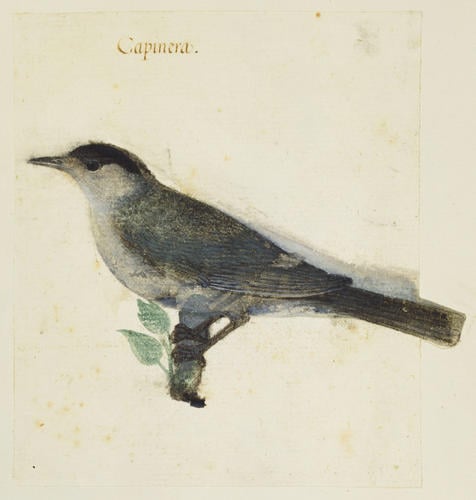-
1 of 253523 objects
Eurasian blackcap (Sylvia atricapilla L. 1758) c. 1619–22
Watercolour and bodycolour; the outlines incised. Corrections in lead white (partly darkened). | 13.6 x 12.8 cm (sheet of paper) | RCIN 927610

Vincenzo Leonardi (1589/90-1646)
Eurasian blackcap, Sylvia atricapilla (L. 1758) c. 1619–22
-
This natural history drawing from the 'Paper Museum' of Cassiano dal Pozzo (1588–1657), shows the blackcap (Sylviidae) in a lifelike posture, with a lively eye. Despite the smudging from significant water damage, the careful observation of subtle plumage coloration is still visible, with the mainly olive-grey upperparts and paler grey cheek and underparts. The most distinctive feature of this warbler is the black head of the male (in the female this is reddish-brown), which caused it to be confused with the great tit, though the blackcap lacks the black chin and black midline stripe of the great tit (see the two Paper Museum drawings of the great tit: RCIN 927621 and a sixteenth-century sheet now in a private collection, Birds, Other Animals and Natural Curiosities 2017, cat. 181).
The sheet belongs to a group of bird drawings commissioned by Cassiano from the artist Vincenzo Leonardi to illustrate a 1622 treatise on birds by Giovanni Pietro Olina titled L'Uccelliera, ovvero discorso della natura e proprietà di diversi uccelli ('The Aviary, or Discourse on the Nature and Characteristics of Diverse Birds'). This drawing was the model for the plate in the Uccelliera, where in his description Olina notes that the blackcap is one of the choicest birds for keeping in captivity on account of its elegance, good nature and the sweetness of its song (a rich musical warbling often ending in a high-pitched crescendo):
‘Of all the birds to be kept in cages, it has a cheerful nature, a delightful, sweet song, and a beautiful appearance, pleasing because of the variety of light and dark plumage throughout its body, with its head, back, primary wing feathers and tail a blackish colour; however, on its head there are marks that are not fully black. The part above the wings inclines towards green with a mixture of earth colour, the underparts yellowish, tending towards white at the abdomen, the bill is black, just slightly hooked at the tip’ (Olina 1622, fol. 9).
In the engraving, the short, perhaps artificial, perch (to which two leaves have been added somewhat awkwardly) is replaced by a tree branch with thick foliage to form an arboreal background suited to the bird’s preferred habitat of deciduous woods. A common and widespread warbler in Italy, the blackcap is a migrant, though it can sometimes be resident in the southernmost regions of Italy. It is found throughout Europe, western Asia and northwestern Africa.
Olina notes that breeders can be confused by catching a similar species, the Sardinian warbler (Sylvia melanocephala Gmelin 1789), known as the occhio cotto (‘cooked eye’, on account of the eye’s red rim); he says that the only difference between the two species is the colouring of the inside of the bill, which is red in the blackcap and yellow in the Sardinian warbler. No drawing is known for the Sardinian warbler (Olina did not include an image in the Uccelliera), though Philip Skippon – an English visitor to the dal Pozzo collection in 1665 – noted seeing one of an ‘occhio cotto [which] is blackish’ (P. Skippon, ‘An account of a journey made thro’ part of the Low-Countries, Germany, Italy and France [1663–6]’, in A. and J. Churchill, A Collection of Voyages and Travels, London 1732 (1752 repr.), vi, pp. 375–749, at p. 693).
Annotations: Capinera.
Engraved: Olina 1622, fol. 8v
Natural History of Birds album (RCIN 970381), fol. 12; laid down on a late eighteenth-century mount sheet (dal Pozzo ‘type G’ mount). Drawing sheet silhouetted around tail; water damage.
Text adapted from Birds, Other Animals and Natural Curiosities, Parts B.IV–V of The Paper Museum of Cassiano dal Pozzo: A Catalogue Raisonné, 2 vols, London 2017, cat. 73 [Henrietta McBurney with Carlo Violani].
Provenance
From the ‘Paper Museum’ of Cassiano dal Pozzo (1588–1657) and his brother Carlo Antonio dal Pozzo (1606–89). Sold by Carlo Antonio's grandson to Clement XI Albani, 1703; acquired by Alessandro Albani in 1714, from whom purchased by George III in 1762.
-
Creator(s)
(collector)Acquirer(s)
-
Medium and techniques
Watercolour and bodycolour; the outlines incised. Corrections in lead white (partly darkened).
Measurements
13.6 x 12.8 cm (sheet of paper)
Category
Object type(s)
Other number(s)
RL 27610